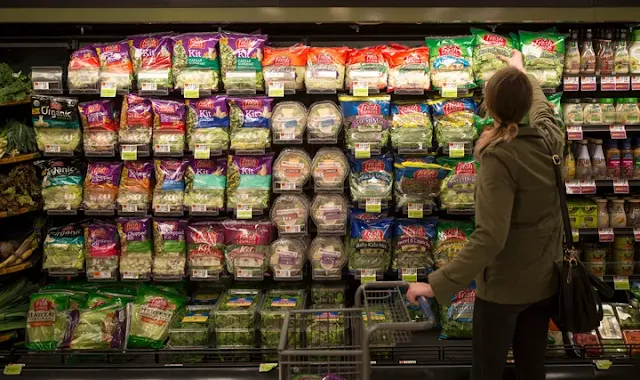Embarking on a healthier eating
journey at the start of the new year is a common resolution. You might kick
things off by delving into salad recipes and stocking up on lettuce and other
greens. However, as days pass, you may find your lettuce losing its crispness.
Pink or red discoloration may appear on romaine leaves, while arugula or
mesclun could be heading towards sogginess or mushiness.
Facing this, you may question whether these alterations render your salad greens unsafe for consumption. Are those peculiar leaves still suitable to eat?
Trevor Craig, a food safety expert
and corporate director of technical training and consulting at Microbac
Laboratories, explains that lettuce, being thin and fragile, easily breaks down
and generates a substantial amount of liquid. However, he clarifies that these
changes don't necessarily mean the greens are unsafe, but rather, you might not
find them appetizing. The mushy or discolored leaves might raise concerns about
food safety, particularly as salad greens are occasionally associated with food
recalls and outbreaks of foodborne illnesses.
To gain a deeper understanding of the transformations in salad greens, food safety, and produce experts elucidate the reasons behind these changes and offer guidance on determining if your lettuce remains safe for consumption.
What causes certain
types of lettuce to develop a pink hue?
The reddish-pink discoloration
observed in romaine and iceberg lettuce, known as “rusting,” is a natural post-harvest characteristic, as explained by
Katie Sabatini, a registered dietitian and food safety and quality assurance
manager at Little Leaf Farms. She clarified that improper handling and storage,
such as bruising, cutting, or excessive moisture during storage, can accelerate
the development of rust on lettuce leaves.
Over time, lettuce undergoes
oxidation, producing polyphenols, plant compounds with various health benefits,
as a protective response against mold and fungi growth. This oxidation can
contribute to the rust-like appearance. Additionally, exposure to ethylene gas
emitted naturally by other produce in the refrigerator can be a contributing
factor.
Although the rusty discoloration may be visually unappealing, Sabatini assured that it doesn't render the lettuce unsafe for consumption. If the pink portions bother you, simply trimming them off is a viable solution. She emphasized that as long as the lettuce remains crisp, and the rest of the leaves appear vibrant and firm, consuming the pink parts is safe.
What causes certain pre-packaged greens to become damp and lose their
crispness?
The delicate nature of leafy greens
renders them susceptible to damage from being bumped or crushed during
harvesting, packaging, or transportation, according to Craig. Consequently,
these greens may appear wilted, dark green, or soggy, but such characteristics
do not necessarily indicate spoilage.
 |
| Prepackaged greens are especially susceptible to getting soggy |
Sabatini pointed out that dark or
wet leaves, however, can be indicative of spoilage. As leafy greens age, they
release moisture, leading to darkening or sogginess. Factors such as
overpacking, fluctuations in temperature during transport, and improper storage
can contribute to increased moisture.
The excess moisture becomes a
breeding ground for harmful bacteria like E. coli, salmonella, or listeria,
heightening the risk of foodborne illnesses, Craig warned. These illnesses may
manifest as symptoms such as diarrhea, stomach cramps, vomiting, and fever, as
outlined by the U.S. Centers for Disease Control and Prevention.
To err on the side of caution, Sabatini recommended discarding any greens that appear limp, soggy, slimy, smelly, or unusually dark, as they are unappetizing and may pose potential health risks.
Considerations for Purchasing Pre-Packaged Greens
Before making a purchase of salad
greens, carefully inspect the package. Avoid buying the product if you observe:
Numerous slimy, dark, or soggy
leaves, indicating that the produce is likely past its prime and may pose a
risk.
Accumulated liquid in the corners
of the package. While a slight amount of moisture is acceptable, it should be
clear and limited to a few drops, as highlighted by Craig.
Mold or black spots on any leaves.
Additionally, always check the
best-by and sell-by dates, advised Sabatini. Best-by dates indicate the
expected freshness duration, not necessarily the safety of consumption. Sell-by
dates guide retailers on display duration, but consumers can use them to select
the freshest pack on the shelf.
Craig added that generally, if the greens still appear fresh beyond the indicated dates on the package, they are likely safe to eat.
Guidelines for Safe Storage and Consumption of Greens at Home
Ensuring the correct storage of
salad greens is essential for prolonging their freshness. Sabatini recommends
keeping leafy greens separate from other fruits and vegetables to minimize
exposure to ethylene gas.
Maintain a cold temperature for the greens, ideally between 34 and 38 degrees Fahrenheit, to slow down rusting and breakdown. Utilizing a crisper drawer provides a consistently cool and somewhat controlled environment for the greens to thrive, according to Sabatini.
Before consumption, carefully inspect
the leaves, removing any that are soggy, discolored, slimy, or wilted to be on
the safe side. Refrain from consuming anything with an unpleasant or sour odor.
While a few spoiled leaves are
unlikely to impact the entire pack, Sabatini advises discarding the entire
package if the majority appears compromised. Consider composting the discarded
greens to address food waste.
“If uncertain about the condition of your leafy greens, it's best to
exercise caution,” she emphasized. “Harmful
foodborne illness-causing microorganisms cannot be seen or smelled.”


0 Comments